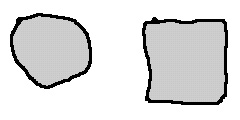

Seeing is believing . . . . Pragnanz
The law of pragnanz suggests that individuals organize their experience in as simple, concise, symmetrical and complete manner as possible.
In the preceding examples, the most elegant organization changed from one figure to the next. Because closure of the whole is very important, in the second figure there is a tendency to seek closure and see rectangles. In the first figure, closure of the lines is less possible, so the entire set is viewed as a whole, rather than as a series of wholes.
![]()
Learning follows the law of Pragnanz.
As learners, we seek to structure our learning in a manner consistent with the law of Pragnanz. Therefore, over time, remembered experience may become simpler, more concise and more complete than was the actual input. While the objects drawn below are somewhat irregular, they are likely to be remembered as a circle and a square.

Tversky studied this phenomenon by having individuals look at maps and reproduce them from memory. Tversky found that individuals tended to straighten curved lines, draw slanted lines in either a north-south or east-west direction, and place other features in alignment with one another.
![]()